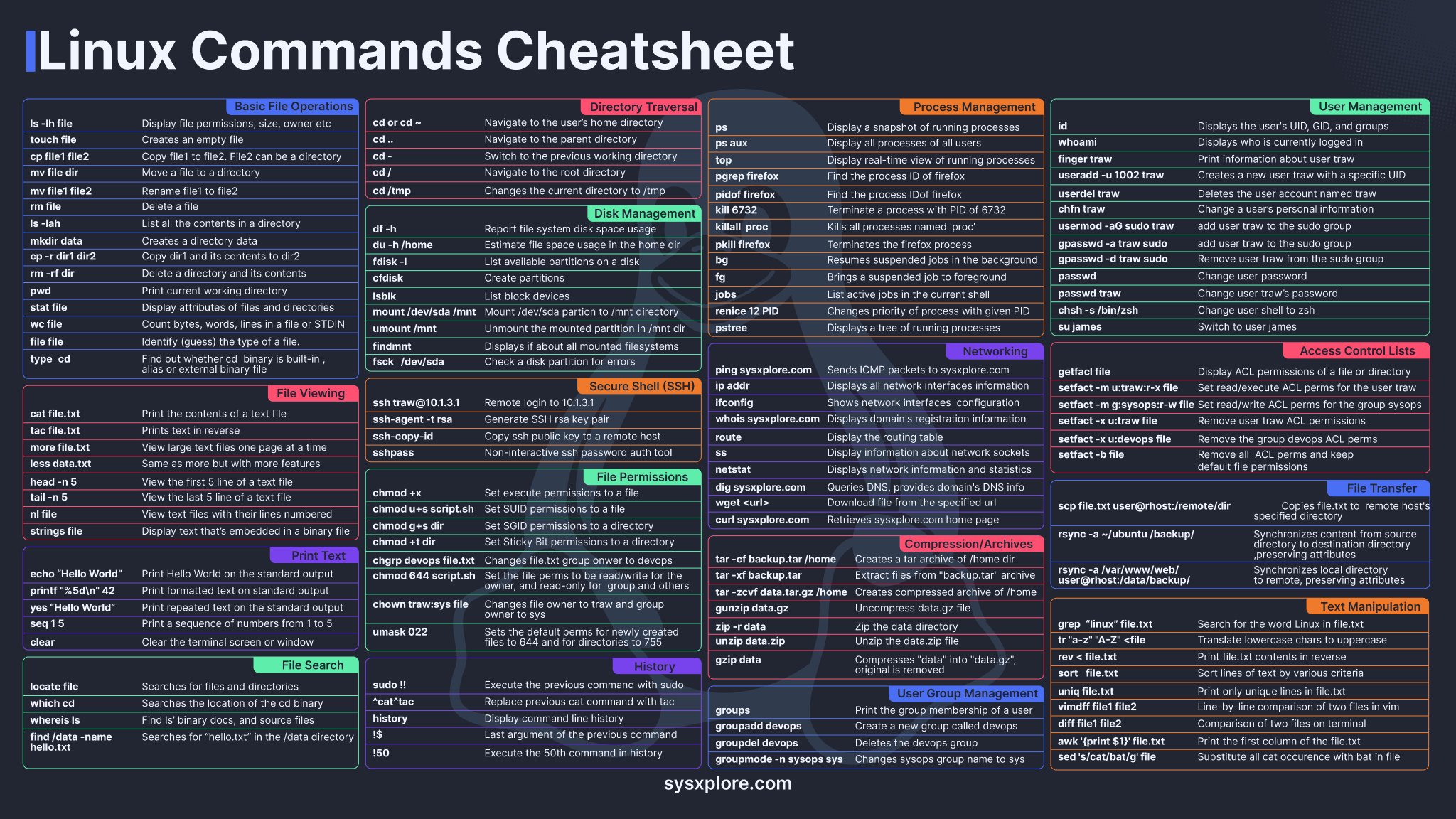I’m a Windows user of all life. But I love Linux. And these last two years after so many time I started learning it in deep . But one thing is bugging me is that I am those persons that has bad times remembering names, words… imagine commands… Even after using it so much I remember some basics but I’m struggling a lot and I have to go back to notes constantly to do some basic operations. Even worst after trying multiple distro from from different upstreams that commands are … Different. What would be your recommendations to help me. Are there tools to help this issue ? My guess is that A LOT of people happens the same. And it’s one of the reasons Linux has such a slow adption . Because is excellent and full of capabilities.
Who needs to remember commands when the shell can type them out for you :)
(Genuinely recommend it, it’s been my daily driver for years)
strg + r
It happens to you, to me and to every UNIX user since the 70s. Your system is (or should be) full of docs and tools to get help. One thing that I noted over the years, when we have new people at work, is that they don’t known how to get help from programs or they don’t known how to get help from their systems and when they struggle with anything, doesn’t matter how basic, they go to the web for help. I always show them this:
aproposmanhelpWhat was that command to compress files?
apropos compressOh! it was gzipWhat was that command to do whatever with the GRUB?
apropos grubOh yeah! update-grubWhat about that command to download files?
apropos downloadOh! it’s wgetThe next tip should be learn how to use and navigate in the
manpages, man have it’s own man page;man manThere are different sections, section 1 is the default, you don’t need to specify, so you can just;
man bashBut if you want to get help from configuration files you should type;
man 5 sysctl.confAlso, almost every program have a built in help compiled with the program code, you usually call it with --help or -h, sometimes just help and other times just call the program without parameters and it should print it.
Other people already suggest the cheat sheets, very useful especially for programas like vim or emacs, some of them come like a template to create a cube, so you print it and then craft it (like an origami) and you can have it in your physical desktop.
Last thing; be patience, your are in the rigth path, there’s always more than one way to do things, you just need to find your own way.
I made a comment about how easy it was to learn VMS was (an 80s/90s OS). How do I print a file? I’ll try PRINT. Okay, that works. How do I make 6 copies? PRINT /COPIES=6. Great! But how do I print to a file? I’ll try PRINT /OUTPUT=filename. Well whaddya know!
I loved that OS like a brother. Sadly it eventually went the way of every proprietary system.
This reply made me smile. You are not going to believe me but I’m a millenian… and I worked with OpenVMS (yes, you guess rigth, in a bank). May I tell you? Yes, sorry;
2012, first week as a SysAdmin in that hell bank, I made the mistake of saying “My fetish are old OS and computers” (this is true), “Well, we have this four VMS baremetal machines that nobody wants to touch and if they fail we fuck up all”. After learning to be quiet and don’t speak too much I found a VMS manual in TPB or some other site (I remebered downloading it as a torrent) and started using the pre ones (two of this machines where pre and two prod). I found that AWK was installed and a POSIX Korn Shell was sleeping there and nobody knew it, with only that I did a lot of stuff like Nagios custom monitoring (yes, this machines wasn’t in the monitoring system, if there is not a red dot isn’t broken) and automated things like the IPLs. I’m not going to say that VMS is a brother, but I feel comfortable with it even for a UNIX admin. The best part of this boring story is that, some months ago I was chatting with one old coworker that is stills in that bank, they still have this machines and they still use my shitty scripts for monitoring and getting data and statistics, can’t believe (and a little proud of) that a OS that was developed before I was born is still up and running my programs.
Not a boring story at all, in fact it’s Awesome! It’s been so long since I touched VMS I would probably be lost now, but I wrote tons of apps and was a sysadmin for a couple years - which I really enjoyed, as 90% of that job was running backups and installing updates, leaving plenty of time to just play around. I missed writing apps, so I made a visual status monitor that let me look at running processes and pause, restart or kill them. My last exposure to VMS was when I worked at Fred Hutchinson Cancer Research Center in 2007 or 8 - a group there still had a VaxCluster running, but I never worked on it. Today there is still OpenVMS, mostly run on emulators by retro computing hobbyists I think.
Thank you!
I think 90% of the comments here are “write your own notes“ - which is possibly over simplistic.
Everyone’s different but IMHO:
The brain is better for imagination than long term storage. So if you’re stuck trying to remember some obscure command(s), it’s just better to use something else to store that on.
But when the brain understands the core concepts well enough, the details come together as habits (where repetition comes in).
So, if you’re unable to recall something, take some time to think / remind yourself about the underlying concepts and why that’s the command - next time it’ll be easier, eventually it’ll be effortless.
I had to learn some strange concepts for work during a deep technical troubleshooting session on a client’s system and the commands were like just facemashing the keyboard… I’ve no idea what those commands are now (written down), but I can recall what / why I was doing them and that was the key… for me.
(Using computers since '80s)
But when the brain understands the core concepts well enough, the details come together as habits (where repetition comes in). This is the way. Understanding core subjects then is easier to connect and recall stuff.
Find a cheat sheet. There are hundreds out there – you probably want one for basic terminal commands, and one for whatever package manager you’re currently using.
The history command is also great if it’s something you do fairly often, but not often enough to remember clearly.
I have around 10 “linux extract tar archive” online searches last year alone.
Exactly!
I default to tar -xvf and if that fails I google
I remember it due to the trinity on the keyboard, x skip a letter v then force the tip with f
eXtract Verbosely File just never really caught on for me
Unless you want to increase productivity in specific field (say some kinds of software development) you won’t even need to remember anything more than cat, ls etc. In those specific usecases you’ll become habituated to the command you use frequently, nobody becomes a grep ninja on day 0.
Whenever I need something mildly complex with ffmpeg or imagemagick, the right command is just a web search away, I rarely remember syntax of these anyway. I find commands less obvious and harder to find for windows shell (technically powershell is cross platform btw), but maybe that’s because I’m not much familiar with windows-ism’
Tip: whenever you encounter a useful command syntax/one liner, save it with brief description. I find konsole’s built in quick commands quite handy, some other terminals probably have such features too. Otherwise a simple markdown list is enough.
Back in the ancient pre-Internet days I worked for many years with a system called VMS made by Digital Equipment Corp (aka DEC), now long gone. VMS was a dream to use - every command and option was an actual word, and you could abbreviate commands and options any way you wanted, As long as you were unambiguous, it would figure out what you meant. So easy to learn, and felt so natural. Based on that alone I thought VMS would become more popular than Unix, with its cryptic commands, and those single-letter options that are sometimes the first letter of something obvious and other times seem totally random. But internally VMS wasn’t structured as well - for example, piping output from one command to another was possible, but it wasn’t geared for that like Unix is. There was also no free version of VMS, and it only ran on DEC hardware, so not that many people even knew about it. The dawn of Linux for PCs was essentially the nail in the coffin for VMS. But I do miss that CLI.
Practice.
Practice.
Practice.
That’s really the best I can give you. The more you use the commands the easier they come to you.
Even novices can struggle with the command line. Don’t be afraid to search online for answers. I still need to look up arguments for things that I don’t use daily and I’ve been using Linux for almost 20 years now. Duck duck go and man are your friends.
One thing that I have found nice is using a shell that remembers what you have typed in the past because sometimes I will remember part of a command but not the whole thing, for example fish shell remembers commands and will start to auto fill commands that are typed as long as I have the beginning of the command correct and as long as I have typed the command in the past, which works wonders when you’re doing similar commands but with different file names or you are trying to remember the more advanced portions of git
A side note that I want to add regarding alternative shells be aware that every shell has its own strengths and weaknesses, for example fish shell is amazing for auto completion and plug in support, but it’s downside is it’s not compatible with standard bash Scripts and scripting as a whole on it is pretty mediocre
Idea 1:
Print out some of the various CLI cheat sheets and pin them to your wall by where you work on your computer.
Maybe this one:

Then, print a page with commands you commonly use, either with more complex syntax or that aren’t on the sheet. (Like, “ls” is on there, but “ls -s -h” is not, for example.
Idea 2:
Write bash scripts to automate some of your commonly used tasks. Comment them. Imagine someone else is going to have to use them, even if you’re the only one who’s ever going to look at them. Not only will this help you learn lots of commands and force you to describe what they do (which will help you retain the information), it will be there as a record of how it works that you can go back and look at months or years later, to remind yourself how to do something.
Yes, write automation. This will lead you to learning new commands that solve problems as you go. Debugging until they work correctly also helps make them more familiar. This is the best way to learn for sure. At least in my own experience, could be different for you, but I strongly suspect this’ll work well.
Use GUIs for all the things.
Linux users are obsessed with the command line because it’s faster if you can type fast and remember everything. If you can’t, GUIs are actually much much faster because you are visually guided towards what you’re looking for and have to spend little time looking for the correct commands and syntax and everything.
This is so true.
I have been using Linux since the mid 90s. Exclusively since about 2005.
I am obviously getting old now. But my willingness to remember the structure of rarly used commands/options. Has always been limited. If its not something I do often. It generally involves looking up man pages. And more often then not a GUI is just faster.
GUI has improved hugly in the time I have been using Linux. To the point that now it really is quicker if I’m not already in the terminal.
But as soon as things get to the multiple command level. Or complex enough that looking up is needed anyway. Typeing is just faster. Being all in one window makes a huge difference. But also once things get to the need to look up point. Command lines are just easy and quick to share online etc. So it tends to be the easy way for forums etc to share guidelines etc.
For all GUI has improved. Text is still one of the easiest ways to share data. It allows things to be organised and jumped around from point to point.
I am teaching an ex GF to use a new Linux PC for the first time. (Put it together as a wedding gift)
I tend to tell her to switch between GUI and command line as best suits her. As long as you understand the goals of each step write or wrong is whatever seems easiest for the user.
But it is important t to become comfortable with the terminal. Because this is how others will share info. And she will need to be able to understand what they are telling her to do.
Online trolls still exist. So understanding things like
sudo rm -rf /
Is essential before typing it.
teaching an ex GF to use a new Linux PC for the first time. (Put it together as a wedding gift)
very cunning revenge!
Grins.
Nah. If i wanted revenge id put windows on it.
They just need an internet PC with Libreoffice.
because it’s faster if you can type fast and remember everything.
No. That’s just wrong. You only need to type ONCE and you don’t have to remember it all, that’s why
reverse-i-search(aka Ctrl-r) is so powerful. It allows you to search within your command history so you only need to remember few letters of the command (which you can annotate, e.g.commandname parameter #it does this) and can even edit after, e.g. changing parameters.But, more fundamentally, that is NOT the point of the command line!
The whole point of the command line is… to be able to repeat things, namely to script actions that can be customizes and combined to YOUR unique needs. So it’s absolutely not about typing speed or memory. In fact, once I do have a good command, what do I do? I save it as a script precisely so that I do NOT have to type it again. Think of commands as Lego bricks that can be combined to together, build on top of. That is basically impractical with GUIs. Sure there are some tools to automate the click on GUIs but it’s unreliable, nor can it be easily shared.
PS: I’m not saying anyone should use the command line over GUIs. I’m not being prescriptive. I’m only trying to clarify what the point of the CLI is.
TL;DR: command line is about combining tools to your unique needs, repetitively and reliably.
True of course. If you look at my comment though, I haven’t said that speed is the point of the command line. Just that Linux users are obsessed with it. For most users most of the time, the repetition/automation is not the point and ability to write scripts is not the most important thing. And you can combine tools with GUIs as well, it’s just slower. Same with reliability, GUIs don’t have to be and usually aren’t unreliable, so command line only has the automation and speed going for it.
you only need to remember few letters of the command
I believe that is exactly the problem in this thread. The command history only works if you remember in the first place.
For most users most of the time, the repetition/automation is not the point and ability to write scripts is not the most important thing.
Well if that’s the case then it’d be like somebody buying a bike, removing the wheels, and complaining that truly it’s not as fast as a car or as convenient as walking. Sure, it’s true but… if one is missing the point of a tool then they can’t really complain about how “bad” it is.
Honestly I do not know how the CLI is most popularly used. I do have usage data for that (and I’m not sure who might, maybe Ubuntu?) but again, if people are using it to “type fast” then they are wrong.
Regarding memorizing and the problem of this thread, yes it IS a problem but that’s precisely why I also commented https://lemmy.ml/post/24395107/15908795 before, namely that someone learning the CLI (namely … ALL of us, even people like me who have been using it for decade, at home and professionally) should actually admit they are learning and thus rely on tools as they otherwise normally would.
Hybrid is best.
I use the GUI quite a lot.
But some things are just easier in CLI, especially if you have to do that thing often.
The other reason to use the command line is automation, it is very easy to write a bash script and run it as often as needed, if every day at midday you want to update something CLI is much easier.
e.g everyday at 2am, my rsync script runs to backup my important files.
e.g 2, I have a small script to combine all the pdf’s in the current directory into a single file using pdftk. It is so much faster than any graphical way.Of course, I didn’t make some kind of point about the general use of GUIs and CLIs, I just said that GUIs are much faster if you can’t remember commands, which is the problem in this thread.
My solutions are:
- Just arrow up until you find the command from last.
- Learn to use CTRL-r and search for old commands.
- Bash completion helps with arguments
- Save stuff in shell scripts
Here is my personal approach to this.
-
I have set my bash history to a ridiculous 1000000 max length, so that I can use CTRL+R to search for commands that I have ran before
-
I write down a lot of commands in a searchable note text document
-
Ask chatGPT
-
Use the
tldrcommand -
Added A LOT of verbose custom aliases and scripts. For example instead of
inotifywait -m -r --exclude "(/tmp.*|/var/cache.*|/dev/pts/|/var/log.*)" -e MOVED_TO -e CREATE -e CLOSE_WRITE -e DELETE -e MODIFY .(nobody can remember that alphabet gibberish)I just type
watch_for_changes .Since it is verbose, straight from my brain, I always remember it and it works with autocomplete. I have like ~30 such commands so far.
Rather than a text file, using a command snippet manager like pet might be more convenient.
That’s an interesting little program. Not sure if it’s for me - I’ll either remember/lookup commands or create bash scripts for more complicated things - but it’s good to know about.
Great concept, but I don’t live in the terminal and prefer GUI text editor features (like jumping the cursor with a mouseclick).
The workflow on the git page looks extremely clunky compared to a good old textfile.
deleted by creator
-
repetition…repetition…repetition…repetition…repetition…repetition…repetition…repetition…lol
I fear not the man who has practiced 10,000 kicks once, but I fear the man who has practiced one kick 10,000 times.
~ Bruce Lee











